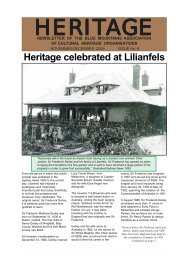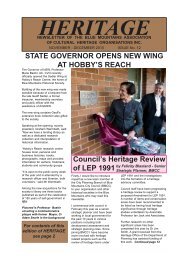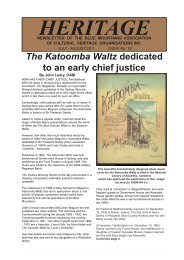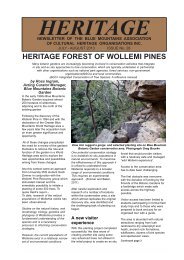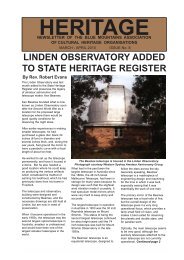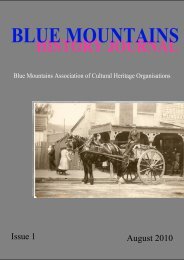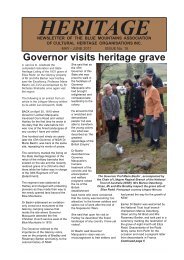Newsletter No - Blue Mountains Association of Cultural Heritage ...
Newsletter No - Blue Mountains Association of Cultural Heritage ...
Newsletter No - Blue Mountains Association of Cultural Heritage ...
Create successful ePaper yourself
Turn your PDF publications into a flip-book with our unique Google optimized e-Paper software.
The Cox’s Road - Context <strong>of</strong> representative<br />
portions<br />
THE COX’S Road Steering Committee was formed in July 2006 to look at long<br />
term objectives and mechanisms to preserve the 1814 Cox’s Road alignment<br />
between Emu Plains and the <strong>Blue</strong> <strong>Mountains</strong> and Bathurst. The committee was<br />
formed with delegates from the Lithgow, <strong>Blue</strong> <strong>Mountains</strong> and Bathurst branches<br />
<strong>of</strong> the National Trust <strong>of</strong> Australia (NSW), and operates under the auspices <strong>of</strong> the<br />
Trust as an informal committee.<br />
In April 2011 the NSW <strong>Heritage</strong> Office concluded it will list representative portions<br />
<strong>of</strong> Cox’s Road as part <strong>of</strong> the 1813 bicentennial celebrations <strong>of</strong> the crossing <strong>of</strong> the<br />
<strong>Blue</strong> <strong>Mountains</strong> in recognition <strong>of</strong> the importance <strong>of</strong> the road in the history <strong>of</strong><br />
opening up western NSW.<br />
Cox’s Road Project Committee (CRPC) convenor, and an individual member <strong>of</strong> BMACHO, Patsy Moppett<br />
pictured, has produced a series <strong>of</strong> articles for HERITAGE to provide some <strong>of</strong> the detail for each precinct <strong>of</strong><br />
the road, this being the introduction to the series as well as the Emu Ford and Woodford precincts.<br />
By Patsy Moppett<br />
AS A follow up to a previous article<br />
on the Cox’s Road in September<br />
2011, it is timely that further<br />
information be shared in regard to<br />
the original road across the <strong>Blue</strong><br />
<strong>Mountains</strong> that opened up the<br />
western region for the wider<br />
settlement <strong>of</strong> the New South Wales<br />
colony.<br />
This monument erected by the RAHS marks the<br />
location where Macquarie declared the site for<br />
Bathurst<br />
It is common knowledge that the<br />
Cox’s Road was followed up in<br />
subsequent years by various other<br />
crossing routes and deviations,<br />
resulting in the Great Western<br />
Highway as we see it today. With<br />
increasing interest in the western<br />
crossings in general, the<br />
significance <strong>of</strong> the original crossing<br />
should be acknowledged.<br />
The Cox’s Road<br />
Project Committee<br />
(National Trust)<br />
(CRPC) made a<br />
submission for<br />
nomination <strong>of</strong><br />
Cox’s Road for<br />
listing on the SHR<br />
under the <strong>Heritage</strong><br />
Act 1977 in 2010,<br />
to record and<br />
register the<br />
significance <strong>of</strong> the<br />
road.<br />
The State <strong>Heritage</strong><br />
Register<br />
Committee <strong>of</strong> the<br />
<strong>Heritage</strong> Council<br />
<strong>of</strong> NSW<br />
considered its<br />
options for listing<br />
all or part <strong>of</strong> the<br />
Cox’s Road.<br />
The SHR<br />
committee was<br />
very enthusiastic<br />
about the proposal<br />
and considered<br />
the route a<br />
significant part <strong>of</strong><br />
NSW history and<br />
heritage.<br />
After considering its options, the<br />
SHR committee concluded that<br />
listing <strong>of</strong> representative portions <strong>of</strong><br />
Cox’s Road would be undertaken as<br />
part <strong>of</strong> the 1813 bicentennial<br />
commemorations <strong>of</strong> the crossing <strong>of</strong><br />
the <strong>Blue</strong> <strong>Mountains</strong> in recognition <strong>of</strong><br />
the importance <strong>of</strong> the road in the<br />
history <strong>of</strong> opening up <strong>of</strong> western<br />
NSW.<br />
It was understood that this would<br />
require extensive consultation with<br />
owners and other relevant<br />
stakeholders.<br />
The significance <strong>of</strong> the road relates<br />
to its place within early colonial<br />
history and society.<br />
Sophisticated technology had little<br />
part to play in the construction <strong>of</strong><br />
the modest structures that enabled<br />
the opening up <strong>of</strong> western NSW,<br />
and the standards and practice <strong>of</strong><br />
road engineering <strong>of</strong> the colonial<br />
period stand out.<br />
The route traversed a rugged and<br />
inhospitable landscape, with<br />
minimal loss <strong>of</strong> life, with efficient<br />
and effective management <strong>of</strong> labour<br />
and equipment, demonstrating<br />
basic work patterns and skills.<br />
The road construction was also<br />
associated with notable public<br />
figures <strong>of</strong> the time including Cox,<br />
Macquarie, Evans and Blaxland.<br />
A report presented by Grace<br />
Karskens in 1988, Cox’s Way, was<br />
carried out as a historical and<br />
archaeological study <strong>of</strong> William<br />
Cox’s Road, which also touched on<br />
other early crossings <strong>of</strong> the <strong>Blue</strong><br />
<strong>Mountains</strong>. Continued page 17<br />
HERITAGE 16<br />
<strong>No</strong>vember - December 2012




